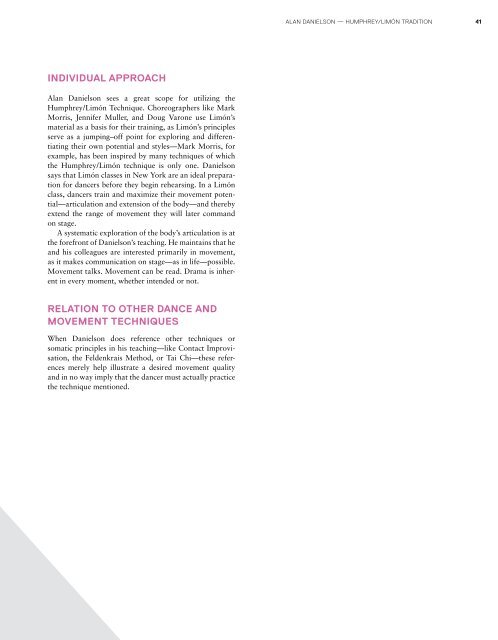Dance Techniques 2010
What does today's contemporary dance training look like? Seven research teams at well known European dance universities have tackled this question by working with and querying some of contemporary dance s most important teachers: Alan Danielson, Humphrey/Limón Tradition, Anouk van Dijk, Countertechnique, Barbara Passow, Jooss Leeder Technique, Daniel Roberts Cunningham Technique, Gill Clarke Minding Motion, Jennifer Muller Muller Technique, Lance Gries Release and Alignment Oriented Techniques. This comprehensive study includes interviews, scholarly contributions, and supplementary essays, as well as video recordings and lesson plans. It provides a comparative look into historical contexts, movement characteristics, concepts, and teaching methods. A workbook with two training DVDs for anyone involved in dance practice and theory. Ingo Diehl, Friederike Lampert (Eds.), Dance Techniques 2010 – Tanzplan Germany. With two DVDs. Berlin: Henschel 2011. ISBN 978-3-89487-689-0 (Englisch) Out of print.
What does today's contemporary dance training look like? Seven research teams at well known European dance universities have tackled this question by working with and querying some of contemporary dance s most important teachers: Alan Danielson, Humphrey/Limón Tradition, Anouk van Dijk, Countertechnique, Barbara Passow, Jooss Leeder Technique, Daniel Roberts Cunningham Technique, Gill Clarke Minding Motion, Jennifer Muller Muller Technique, Lance Gries Release and Alignment Oriented Techniques.
This comprehensive study includes interviews, scholarly contributions, and supplementary essays, as well as video recordings and lesson plans. It provides a comparative look into historical contexts, movement characteristics, concepts, and teaching methods. A workbook with two training DVDs for anyone involved in dance practice and theory.
Ingo Diehl, Friederike Lampert (Eds.), Dance Techniques 2010 – Tanzplan Germany. With two DVDs. Berlin: Henschel 2011. ISBN 978-3-89487-689-0 (Englisch) Out of print.
You also want an ePaper? Increase the reach of your titles
YUMPU automatically turns print PDFs into web optimized ePapers that Google loves.
Alan Danielson — Humphrey/Limón Tradition<br />
41<br />
Individual Approach<br />
Alan Danielson sees a great scope for utilizing the<br />
Humphrey / Limón Technique. Choreographers like Mark<br />
Morris, Jennifer Muller, and Doug Varone use Limón’s<br />
material as a basis for their training, as Limón’s principles<br />
serve as a jumping–off point for exploring and differentiating<br />
their own potential and styles—Mark Morris, for<br />
example, has been inspired by many techniques of which<br />
the Humphrey / Limón technique is only one. Danielson<br />
says that Limón classes in New York are an ideal preparation<br />
for dancers before they begin rehearsing. In a Limón<br />
class, dancers train and maximize their movement potential—articulation<br />
and extension of the body—and thereby<br />
extend the range of movement they will later command<br />
on stage.<br />
A systematic exploration of the body’s articulation is at<br />
the forefront of Danielson’s teaching. He maintains that he<br />
and his colleagues are interested primarily in movement,<br />
as it makes communication on stage—as in life—possible.<br />
Movement talks. Movement can be read. Drama is inherent<br />
in every moment, whether intended or not.<br />
Relation to Other <strong>Dance</strong> and<br />
Movement <strong>Techniques</strong><br />
When Danielson does reference other techniques or<br />
somatic principles in his teaching—like Contact Improvisation,<br />
the Feldenkrais Method, or Tai Chi—these references<br />
merely help illustrate a desired movement quality<br />
and in no way imply that the dancer must actually practice<br />
the technique mentioned.


















